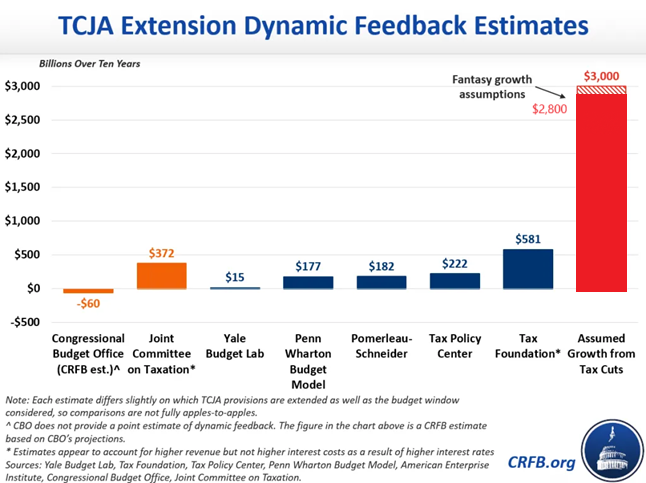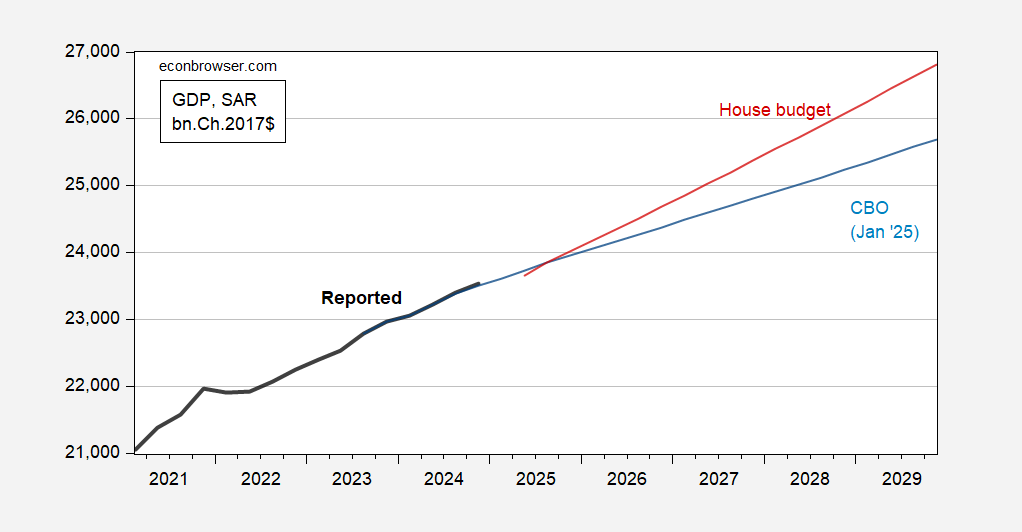The House Budget, as expected, is not a serious document — see the tables. I’ll skip the fantasy spending cuts, and focus on revenue plans. From CRFB:
The budget resolution assumes $2.6 trillion of macroeconomic feedback, which press reports have indicated is a result of boosting average annual growth to 2.8 percent from a projected 1.8 percent. If one were to assume the House budget’s $2.6 trillion of economic feedback from 2.8 percent average annual growth and $3.3 trillion of net deficit increases, debt would reach 105 percent of GDP by 2034 and the deficit would total 5.6 percent of GDP in 2034.
Here’s a comparison of various estimates compared to the House plan’s estimate.
Notes: Modified by author to match current estimates of dynamic response. Source: CRFB.
The assumed dynamic feedback requires a tremendous supply side response. To see how this alternative worldview compares to CBO current law projection, see Figure 1.
Figure 1: GDP (bold black), CBO projection (light blue), House budget assumed growth (red), all in bn.Ch.2017$ SAAR. Source: BEA advance, CBO January 2025, and author’s calculations.
It’s not surprising that the plan is so crazy. Clearly, it’s a linear descendent of the RSG document.


This is simply the next step in writing down results before doing the work that is is claimed to result in those results. It’s the Republican way.
And it doesn’t matter. Their voters either don’t care, don’t understand, or both. They are so far down that path that they can’t come back. Imagine telling their base that government is beneficial, regulations are valuable, vaccines work and that public schools are an essential ingredient in our prosperity. Primaried. Out. Done.
True MAGA doctrine cannot fail, it can only be failed. Economic growth is the result of 1) growing labor supply; 2) productive growth based on capital investment and increasing labor productivity through training and technological improvement; 3) business entrepreneurship taking advantage of those improvements to create businesses for new niches or improved business models for existing niches. Movement Conservative Doctrine, as handed down to MAGA, has argued since the let seventies says “cut taxes on rich people,” “assume a unicorn,” and then big boosts to 3) will lead to 1 & 2 happening. What is happening now is MAGA is determined to expel a minimum of 10 million, and perhaps as many as 30 million non-white workers from the U.S. Econonomy, thereby shrinking (1), while devastating scientific research, education, and public infrastructure investment (2), and meantime, in the short term, delivering a huge “demand shock” with a rapid and huge Fiscal retrenchment in both 2025 and 2026. I don’t think those growth targets are going to be met.
Reuters is reporting that US negotiators have threatened cutting off Ukraine’s access to Starlink if they don’t sign a deal giving the US 50% of all mineral resources.
Starlink is the satellite based internet service that is critical to all of Ukraine’s military communications, defense and drone controllers. Without it they are sitting ducks to Russian aggression.
Starlink is a division of Elon Musk’s SpaceX. And the rare earth minerals in question are essential to Elon Musk’s electric vehicle production. So the US is using Musk’s Starlink business to extort minerals for Musk’s car business.
I told you Elon Musk is the most dangerous man on the planet. He’s more dangerous than Trump.
He is only dangerous because he is acting as Trump’s tool right now.
“He is only dangerous because he is acting as Trump’s tool right now.”
No, Musk is dangerous in his own right. Trump needs Musk more than Musk needs Trump.
Trump may never have been elected without the more than $290 million Musk put into the election. Musk is doing the same around the world — Germany, Italy, UK, Brazil, Argentina.
As with Ukraine, Musk has the power of life or death over entire countries. He has the power of more than 220 million loyal brown shirt social media followers behind him, much more than Trump ever had.
With $400 million dollars, he has every Republican senator and congressman at his beck and call, terrified of being primaried by tens of million of dollars against anyone who defies him. He has put over a million dollars into the Wisconsin Supreme Court election in April.
Trump is just a lazy narcissist whose only goals are petty grifting and cloying adoration. Musk is a sociopath with much grander aspirations of changing the entire planet to his dictatorial rule by techbros.
He’s much more dangerous than Trump and will continue to be a danger long after Trump is gone.
The CBO is a creature of Congress. The House is part of Congress. Yet they disagree on the fiscal consequences of budget proposals.
How long will the CBO be allowed to publish such treasonous estimates?
great article